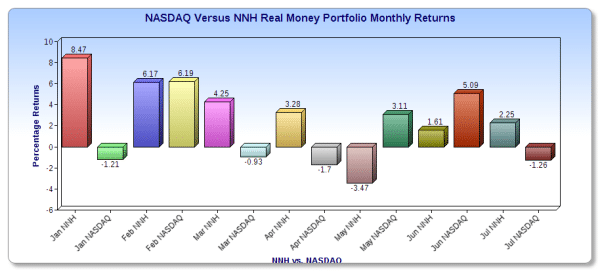How to Achieve a 24% Return in 7 Months
I'll be the first to admit that this article is coming a bit late.
Reporting a portfolio's 7 month performance isn't exactly normal -- but I wanted to give you a sense of how our real money portfolio has done net of fees this year and how you can do the exact same thing with your investments.
Start With a Great Base Investment Strategy
It's hard to do well in stocks and investing if you don't start with a great core strategy. Value investing gives smart investors a good overall philosophy to use when approaching investing, but there are a lot of investment strategies within the value investing framework.
It's no secret to those who are getting a free net net stock checklist that I've become completely obsessed with Graham's net net stocks strategy. It should also be no surprise why -- Graham's net net stocks have consistently shown themselves to be the highest returning classic value investing strategy. While it's possible to achieve 20% returns using a low PE, price to cash flow, or price to book value approach, net net stocks tend to average between 20% and 35% per year.
This is likely why Warren Buffett made net net stocks a huge part of his portfolio when he first started out. Incidentally, it's also when Warren Buffett racked up his largest returns as a professional money manager.
Safety Comes First When Investing
Net net stocks are stocks of deeply troubled companies. As such, they're subject to a larger rate of catastrophic failure than your average stock on the S&P 500.
While that might scare some people away, keep in mind that the rates for both net net stocks and your typical stock on the stock market are extremely low. An S&P 500 stock has a 2% chance of declining in price by 90% or more... while a net net stock has a 5% chance.
Those are small numbers, but protecting your downside can still really boost your returns.
Two ways I protect my downside is by looking for companies that have great but easily identifiable qualitative aspects, and are sound financially. When it comes to great qualitative factors, this typically amounts to looking for firms that are buying back stock, raising their dividends, have large insider ownership, or have insiders who are buying the company's stock. All of these are strong indicators of better times ahead.
When it comes to being solid financially, I generally look for firms with less than a 25% interest bearing debt to equity ratio, and a large current ratio. Bonus points go to those firms that are improving in these areas. While I may be wrong on this, it's my assumption that firms without debt don't go bankrupt. By looking for a strong balance sheet, you can avoid the occasional large loss which will ultimately boost your portfolio returns.
Practice Proper Portfolio Strategy
Benjamin Graham suggested that net net stock investors invest in at least 30 NCAV stocks to take advantage of the statistical returns of the group. Joel Greenblatt suggested that an investor needs far fewer stocks to diversify away systemic risk.
Even as the American market reaches a valuation not seen since the late 1990s, it's still possible to put together a 30 stock NCAV portfolio. Of course, you'd be investing most of your money outside of the US in much more reasonably priced markets, but you can still find very cheap net net stocks.
I, myself, am trying to balance the best quality net net stocks with adequate diversification, so have opted for an 8-10 stock portfolio. This closely aligns with Greenblatt's thoughts on diversification and should allow me to protect my down side while also taking advantage of the safest and highest returning net net stocks. The downside is that my portfolio will be more volatile, but I'm comfortable with that.
One major mistake I made over the past 3 years was not being fully invested. You have to play to win, and that means not sitting on the sidelines. While my portfolio performance is up roughly 140% since the start of 2011, cash dragged down my portfolio returns. I just didn't have enough decent quality stocks to build a portfolio, so routinely had 20% of my money in cash.
Actually, that's what lead me to create Net Net Hunter in the first place. As of today, Net Net Hunter covers net net stocks in 6 countries (the UK, Canada, the USA, Australia, Tokyo, and Hong Kong), which collectively have over 500 stocks that meet the statistical requirements of being net net stocks. I've also hand screened those 500 stocks to come up with the 40 best investment opportunities as I see it, 34 of which are sitting under a large margin of safety.
Net Net Hunter's 7 Month Returns Month by Month
When I first started out I had the silly notion that a 15% average annual return meant that those stocks would go up 15% per year. That's obviously just not the case. Those results are an average, meaning that there will be some years in which you see losses, and some years in which you see great results. That's the nature of investing, if you're doing it right.
The same goes for monthly returns. I've listed Net Net Hunter's real money portfolio returns month by month to give you a good sense of how the portfolio has done this year and to give you a better sense of the volatility involved.

Overall, the group of net nets picked using my selection criteria worked out very well. The portfolio has only had one money-losing month, versus the 4 losing months that the NASDAQ has had. That's huge. After any down period, a portfolio has to make up lost ground to get back to break even. Even if your portfolio returns nothing in a given period, while the index declines, you get to start from where you left off in the previous period while the index has to climb out of its hole.
The Net Net Hunter real money portfolio has also beaten the NASDAQ in 4 of the 7 months. That is fairly typical of net net stocks generally -- they tend to beat the index 60% of the time, and lose money in fewer periods than the index. Both of these contribute to the strategy's outperformance in a very real way and mirror my own fantastic returns using this strategy over the last 4 years.
My Net Net Stocks
The heart of any portfolio are its well chosen stocks. Net Net Hunter's real money portfolio is no different.
Over the period I've had 6 positions make significant contributions to the portfolio, with a couple stocks being liquidated after an insignificant impact on the portfolio. The positions that were liquidated either came up against my 3 year cut off or had run up in price previously and we due to be closed out.
Unfortunately my bad habit of holding more cash than I should still hasn't been shaken, and I continue to research firms to stuff into my portfolio. As it stands today, the portfolio consists of 7 positions and I'm 14% in cash. I plan on rebalancing the portfolio sometime soon and adding three more positions to my portfolio to bring it up to 10.
Some notable attributes of my holdings at the time of purchase:
Stock A - $5.8 million Canadian market cap, net cash, improving earnings, buying back shares, no debt, price to NCAV of 56%
Stock B - $6.83 million US, increasing NCAV/Share, 11% insider ownership, profitable, price to NCAV of only 40%
Stock C - $17 million Australian market cap, no debt, in the depths of a biblical cyclical downswing for its industry, tiny burn rate of 5.8%
Stock D - 5 billion yen market cap, PE of 6.25x, 9% dividend yield, increasing its dividend, increasing earnings, increasing NCAV
Stock E - 1.88 billion yen market cap, PE of 8.6x, increasing earnings over the last 4 years, price to NCAV of 44%, solid dividend, increasing NCAV
Stock F - 2.33 million GBP market cap, PE of 7.25x, insiders own 31% of the company, no debt, increasing earnings rapidly, buying back stock, price to NCAV of 68%
Stock G - 21.59 billion yen, price to NCAV of 46%, 12% debt to equity ratio, earnings have seen a CAGR of 22%, PE of 7.94x, management is busily buying back shares
Click Here to view my 2014 10 month returns.
You'll immediately notice the size of these stocks. They're tiny... by choice. Generally speaking, the smaller the NCAV firm, the better the associated stock does. The difference isn't small, either -- net net stocks of tiny companies tend to outperform the stock of larger companies by 5-10% per year on average. So, it's obvious, why I selected such small firms.
If these stocks are too small for you, there are plenty of larger firms trading under NCAV... but most of them are available in Japan. Stock G, for example, has a market cap equivalent to $214 million USD.
Aside form deep market corrections, firms trading below NCAV tend to have market caps of less than $50 million USD. Despite what you may think of their small size, tiny net net stocks are liquid enough to buy, are often backed by real value, have long business histories, are lead by honest management, do fantastically well as a group, and are a real opportunity for smaller retail investors.
You can find a lot of these firms trading on friendly international markets, such as the USA, Canada, the UK, and Australia.
Secure Your Financial Future -- Start Right Now For Free
I've been sitting in cash due to the enormous amount of work it's taken to build Net Net Hunter. Over the next couple of months I plan on initiating a few more positions in high quality stocks to round out my portfolio.
If you want to start building a portfolio with fantastic profit potential, there's no easier way than requesting a free net net stock essential guide. No obligation, no catch, and we keep your email address 100% confidential. Enter your email address in the box below right now.






